This article was medically reviewed by Luba Lee, FNP-BC, MS. Luba Lee, FNP-BC is a Board-Certified Family Nurse Practitioner (FNP) and educator in Tennessee with over a decade of clinical experience. Luba has certifications in Pediatric Advanced Life Support (PALS), Emergency Medicine, Advanced Cardiac Life Support (ACLS), Team Building, and Critical Care Nursing. She received her Master of Science in Nursing (MSN) from the University of Tennessee in 2006.
There are 12 references cited in this article, which can be found at the bottom of the page.
wikiHow marks an article as reader-approved once it receives enough positive feedback. This article has 12 testimonials from our readers, earning it our reader-approved status.
This article has been viewed 959,453 times.
A broken finger occurs when you fracture one of the bones in any of your fingers. Your thumbs have 2 bones and your other digits have 3 bones. Broken fingers are common injuries, and they can happen due to a fall while playing sports, fingers getting caught in car doors, bending your finger in an awkward position, or other accidents. To treat your finger properly, you should first determine how severe your injury is. You can then apply home treatment before you head to the nearest hospital.[1]
Steps
Determining the Severity of the Injury
-
1Check your finger for any bruising or swelling. Bruising and swelling will likely occur because you have broken tiny blood vessels in your finger. If you have fractured the fingertip, there will likely be purple blood visible underneath your nail and bruising on the pad of your finger.[2]
- You may also feel a sharp pain when you touch the finger. This is a symptom of a broken finger. Some people can still move their finger even if it’s broken, and may experience numbness or a dull pain. But these could still be signs of a fractured or broken finger and require immediate medical attention.[3]
- Watch out for numbness or tingling as well, since these can be symptoms of nerve damage caused by a broken bone.
-
2Check for loss of capillary refill by pressing gently on the area. Capillary refill is the return of blood to the finger after pressure has been applied. You can test this by pressing gently on the tissue near the injury to make it turn pale. If the normal color doesn’t return in a few seconds, then blood isn’t flowing to the area normally.[4]
- If you aren’t able to see a difference in your skin color when you press on it, try using your nail bed, instead. Gently press your fingernail, then watch how long it takes for it to turn pink again.
Advertisement -
3Examine your finger for any exposed cuts or bones. You may see large open wounds or pieces of bone that have broken your skin and are sticking out of your skin. These are signs of a severe fracture, known as a compound fracture. If you have these symptoms, you should seek immediate medical attention.[5]
- You should also get immediate medical care if there is a lot of blood coming from an open wound on your finger.
-
4Check if your finger looks deformed. If part of your finger is pointing in a different direction, the bone is probably broken or dislocated. A dislocated finger occurs when the bone has moved out of position and usually looks deformed at a joint, such as your knuckle.[6] You should see a doctor if you have a dislocated finger.
- There are 3 bones in each of your fingers and they are all arranged in the same manner. The first bone is the proximal phalanx, the second bone is the middle phalanx, and the bone farthest from your hand is the distal phalanx. Because your thumb is the shortest finger, it does not have a middle phalanx. Your knuckles are joints formed by the bones of your fingers. Often, you break your finger at the knuckles, or the joints.[7]
- Breaks at the base of your finger (the distal phalanx) are usually easier to treat than fractures at your joints or knuckles.[8]
-
5Note if the pain and swelling goes down after a couple of hours. If your finger is not deformed or bruised, and the pain and swelling eventually subside, you may have just sprained your finger. A sprain means you have stretched the ligaments, which are the bands of tissue that hold the bones in your finger together at the joint.[9]
- If you think you have a sprained finger, avoid using the finger. Check to see if the pain and swelling gets better over the next day or two. If the pain and swelling does not go away, you should get medical treatment to confirm the finger is only sprained and not fractured or broken. A physical and x-rays will determine this.
Treating the Finger on the Way to the Doctor
-
1Apply ice to the finger. Wrap the ice in a towel and apply it to the finger on your way to the emergency room. This will reduce swelling and bruising. Never apply ice directly to your skin.[10]
- Keep your finger elevated as you ice it, above your heart. This will allow gravity to help reduce the swelling and bleeding.
-
2Make a splint. A splint will keep your finger elevated and hold it in place. To make a splint:
- Take a long thin item, as long as your broken finger, such as a popsicle stick or a pen.
- Place it next to your broken finger, or have a friend or family member help you hold it in place.
- Use medical tape to wrap together the stick or pen and your finger. Wrap it loosely. The tape should not squeeze or pinch your finger. If your finger is wrapped too tightly, this can cause additional swelling and cut off circulation to your injured digit.[11]
-
3Try to remove any rings or jewelry. If possible, try to slide off any rings on your finger before the finger swells. It will be much harder to remove the rings once your finger swells up and starts to feel painful.[12]
-
4Take acetaminophen (Tylenol) to treat the pain. If you’re in a lot of pain, take an acetaminophen-based medication, such as Tylenol or Paracetamol, to take the edge off. Don’t take any NSAIDs (non-steroidal anti-inflammatory drugs), such as ibuprofen, until you’ve seen the doctor and they tell you it’s safe to do so.[13]
- Some studies show that NSAIDs can slow down the healing process if you have broken bones, so your doctor may recommend avoiding these kinds of medications if you have a fracture.[14]
- Icing your finger will also help numb the pain and keep any swelling down.
Getting Medical Treatment
-
1Receive a physical from your doctor. Your doctor will ask for your medical history and perform a physical on you to get more information about you and to see how the injury occurred. They will check for deformity, damage to your nerves or blood vessels, problems with the position of the finger (such as twisting or dislocation), and skin lacerations or injury.
-
2Let your doctor do an X-ray of your finger. This will allow them to confirm whether there is a fracture of the bone in your finger. There are 2 types of fractures: simple and complex. The type of fracture you have will determine your treatment.[15]
- Simple fractures are breaks or cracks in the bone that do not break through the skin.
- Complex fractures are breaks in which the bone sticks though the skin.
-
3Allow your doctor to splint your finger if you have a simple fracture. A simple fracture is when the finger is stable and there are no open wounds or cuts on the skin of the broken finger. The symptoms will likely not get worse or cause complications with your ability to move your finger once it is healed.[16]
- In some cases, your doctor may strap your broken finger to the finger next to it, known as buddy taping. The splint will hold your finger in position as it heals.[17]
- Your doctor may also move the bone back into place, a procedure known as reduction. You will be given a local anesthetic to numb the area. Your doctor will then realign the bone.
-
4Talk to your doctor about pain medication. You can take over-the-counter pain medication to reduce swelling and pain, but you should still check with your doctor about which medicines are right for you and how much you can take each day.[18]
- Your doctor can also give you a prescription for pain medication to decrease the pain, depending on the severity of your injury.
- If you have an open wound on the finger, you may need antibiotics or a tetanus shot. This medicine will prevent any infection caused by bacteria entering the wound.
-
5Consider surgery if the injury is complex or severe. If the fracture is severe, you may need surgery to stabilize the broken bone.
- Your doctor may recommend open reduction surgery. The surgeon will make a small cut on your finger so they can see the fracture and move the bone. In some cases, the surgeon may use small wires or plates and screws to keep the bone in place and allow it to heal properly.
- These pins will later be removed once your finger has healed.
-
6Get a referral for an orthopedic surgeon or hand surgeon. If you have a compound fracture, bad break, nerve injury, or vascular compromise (damage to the blood vessels in your hand), your doctor may refer you to an orthopedic surgeon (bone and joint specialist) or a hand surgeon.[19]
- These specialists will then examine your injury and determine if your injury requires surgery.
Taking Care of the injury
-
1Keep the splint clean, dry, and elevated. This will prevent any infection, especially if you have open wounds or cuts on your finger. Keeping your finger elevated will also help to keep your finger in position and let it heal properly.[20]
-
2Do not use your finger or hand until your follow-up appointment. Use your non-injured hand for daily things like eating, bathing, and picking up objects. It's important you give your finger time to heal without any movement or disturbance of the splint.[21]
- Your follow-up appointment with a doctor or hand specialist should be one week after your initial treatment. At the follow-up appointment, the physician will check that the bone fragments are still aligned and healing properly.[22]
- For most fractures, you will need up to 6 weeks of rest before you can return to sporting activity or work.
-
3Start moving your finger once it is out of the splint. As soon as your doctor confirms your finger has healed and it is out of the splint, it's important to move it around. If you keep it splinted for too long, or immobile after it is out of the splint, the joint will stiffen and your finger will become harder to move and use.[23]
-
4See a physiotherapist if your injury is severe. The physiotherapist can give you advice on how to regain normal movement in your finger. They may also give you gentle hand exercises you can do to keep your finger moving and to ensure it regains its mobility.[24]
Expert Q&A
Did you know you can get expert answers for this article?
Unlock expert answers by supporting wikiHow
-
QuestionHow do I treat my injured finger?
 Chris M. Matsko, MDDr. Chris M. Matsko is a retired physician based in Pittsburgh, Pennsylvania. With over 25 years of medical research experience, Dr. Matsko was awarded the Pittsburgh Cornell University Leadership Award for Excellence. He holds a BS in Nutritional Science from Cornell University and an MD from the Temple University School of Medicine in 2007. Dr. Matsko earned a Research Writing Certification from the American Medical Writers Association (AMWA) in 2016 and a Medical Writing & Editing Certification from the University of Chicago in 2017.
Chris M. Matsko, MDDr. Chris M. Matsko is a retired physician based in Pittsburgh, Pennsylvania. With over 25 years of medical research experience, Dr. Matsko was awarded the Pittsburgh Cornell University Leadership Award for Excellence. He holds a BS in Nutritional Science from Cornell University and an MD from the Temple University School of Medicine in 2007. Dr. Matsko earned a Research Writing Certification from the American Medical Writers Association (AMWA) in 2016 and a Medical Writing & Editing Certification from the University of Chicago in 2017.
Family Medicine Physician
-
QuestionHow long do I have to leave the splint on a broken finger?
 Chris M. Matsko, MDDr. Chris M. Matsko is a retired physician based in Pittsburgh, Pennsylvania. With over 25 years of medical research experience, Dr. Matsko was awarded the Pittsburgh Cornell University Leadership Award for Excellence. He holds a BS in Nutritional Science from Cornell University and an MD from the Temple University School of Medicine in 2007. Dr. Matsko earned a Research Writing Certification from the American Medical Writers Association (AMWA) in 2016 and a Medical Writing & Editing Certification from the University of Chicago in 2017.
Chris M. Matsko, MDDr. Chris M. Matsko is a retired physician based in Pittsburgh, Pennsylvania. With over 25 years of medical research experience, Dr. Matsko was awarded the Pittsburgh Cornell University Leadership Award for Excellence. He holds a BS in Nutritional Science from Cornell University and an MD from the Temple University School of Medicine in 2007. Dr. Matsko earned a Research Writing Certification from the American Medical Writers Association (AMWA) in 2016 and a Medical Writing & Editing Certification from the University of Chicago in 2017.
Family Medicine Physician
-
QuestionI think I broke my finger. It is hard to move an I can't straighten it or bend it down all the way. It is really swollen and bruised. Should I go get an x-ray?
 Luba Lee, FNP-BC, MSLuba Lee, FNP-BC is a Board-Certified Family Nurse Practitioner (FNP) and educator in Tennessee with over a decade of clinical experience. Luba has certifications in Pediatric Advanced Life Support (PALS), Emergency Medicine, Advanced Cardiac Life Support (ACLS), Team Building, and Critical Care Nursing. She received her Master of Science in Nursing (MSN) from the University of Tennessee in 2006.
Luba Lee, FNP-BC, MSLuba Lee, FNP-BC is a Board-Certified Family Nurse Practitioner (FNP) and educator in Tennessee with over a decade of clinical experience. Luba has certifications in Pediatric Advanced Life Support (PALS), Emergency Medicine, Advanced Cardiac Life Support (ACLS), Team Building, and Critical Care Nursing. She received her Master of Science in Nursing (MSN) from the University of Tennessee in 2006.
Board-Certified Family Nurse Practitioner
References
- ↑ http://www.ncbi.nlm.nih.gov/pmc/articles/PMC2684218/
- ↑ http://www.nhs.uk/conditions/broken-finger/Pages/Introduction.aspx
- ↑ http://www.medicinenet.com/broken_finger/page3.htm
- ↑ https://medlineplus.gov/ency/article/003394.htm
- ↑ http://www.medicinenet.com/broken_finger/page3.htm
- ↑ http://www.nhs.uk/conditions/broken-finger/Pages/Introduction.aspx
- ↑ http://www.emedicinehealth.com/broken_finger/article_em.htm
- ↑ http://orthoinfo.aaos.org/topic.cfm?topic=a00011M
- ↑ http://www.nhs.uk/conditions/broken-finger/Pages/Introduction.aspx
- ↑ http://www.medicinenet.com/broken_finger/page4.htm
- ↑ http://www.medicinenet.com/broken_finger/page4.htm
- ↑ http://www.medicinenet.com/broken_finger/page4.htm
- ↑ https://www.nhs.uk/conditions/broken-finger/
- ↑ https://www.consumerreports.org/cro/news/2009/03/q-a-ibuprofen-risky-for-broken-bones/index.htm
- ↑ http://www.emedicinehealth.com/broken_finger/page4_em.htm
- ↑ http://www.emedicinehealth.com/broken_finger/page4_em.htm
- ↑ http://www.nhs.uk/conditions/broken-finger/Pages/Introduction.aspx
- ↑ https://www.drugs.com/cg/finger-fracture.html
- ↑ http://www.medicinenet.com/broken_finger/page4.htm
- ↑ http://www.nhs.uk/conditions/broken-finger/Pages/Introduction.aspx
- ↑ http://www.medicinenet.com/broken_finger/page5.htm
- ↑ http://www.nhs.uk/conditions/broken-finger/Pages/Introduction.aspx
- ↑ http://www.nhs.uk/conditions/broken-finger/Pages/Introduction.aspx
- ↑ http://www.medicinenet.com/broken_finger/page4.htm
About This Article
If you or someone you know has broken a finger, go to an emergency room to get a proper diagnosis and treatment. On your way to the doctor, elevate the finger above the heart, since this will allow gravity to help reduce swelling. Once the broken finger is elevated, wrap some ice in a towel and apply it to the finger to ease the pain and help avoid bruising. If the finger has any rings on it, try your best to slide them off before the finger swells because they’ll be much harder to remove later on. You should also hold the finger in place by making a simple splint out of a long, thin item, like a popsicle stick or pen, and wrapping it to the finger with medical tape. For more help from our Medical co-author, including how to determine the severity of the injury, read on.
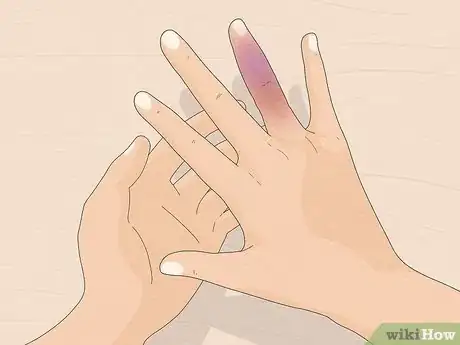
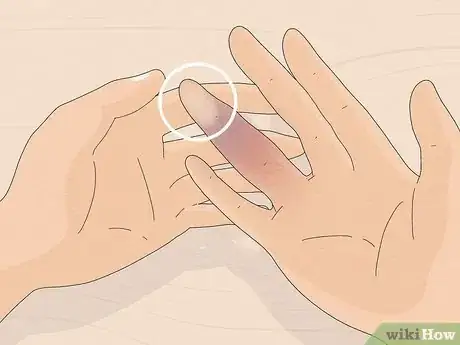
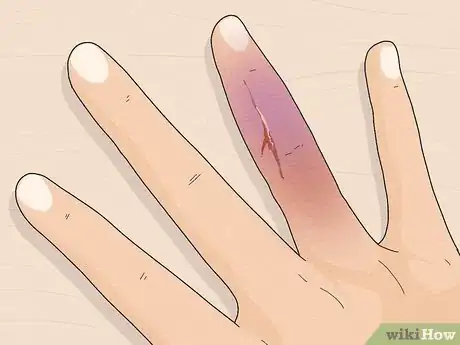
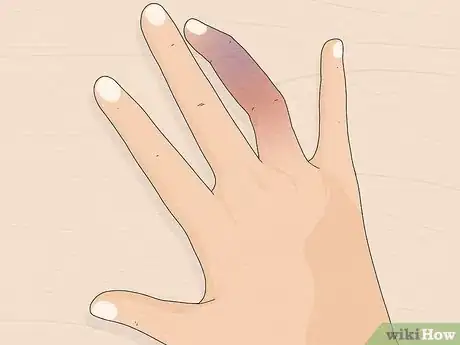

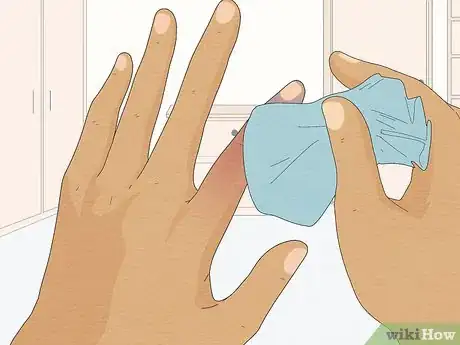
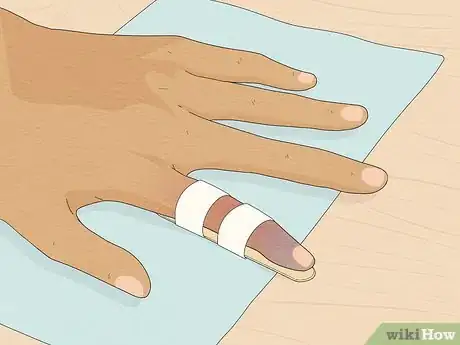
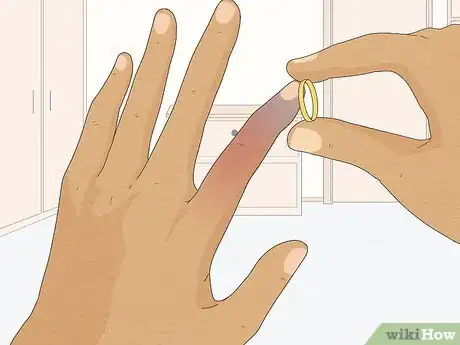
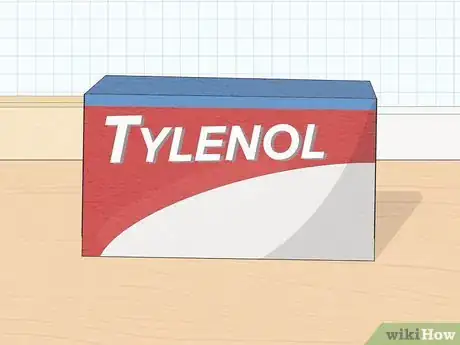
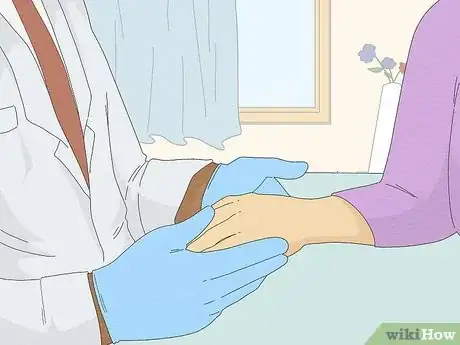

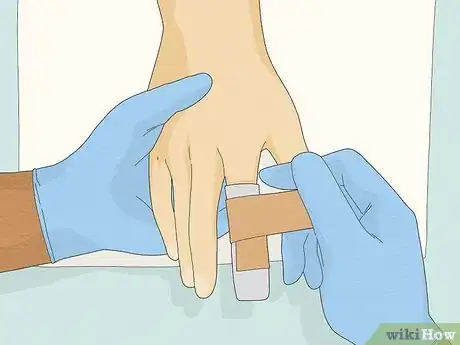

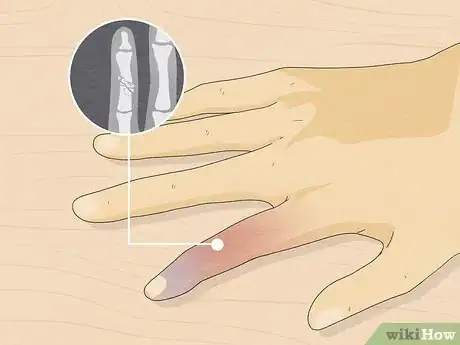
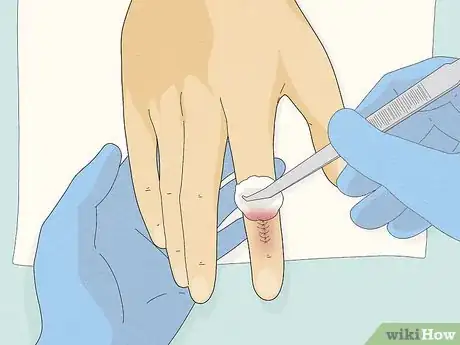

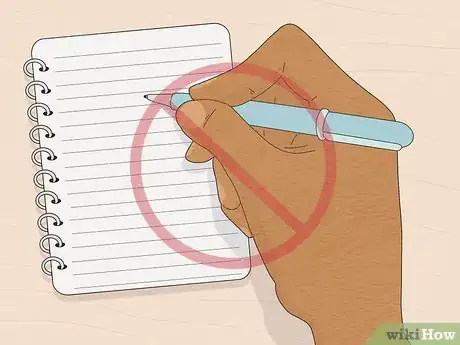
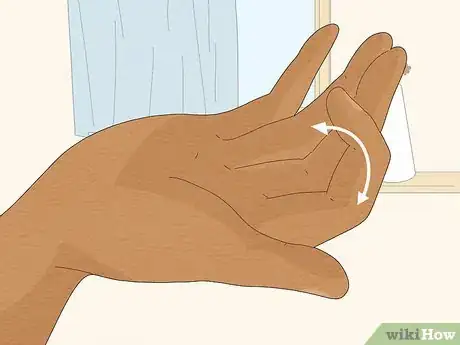



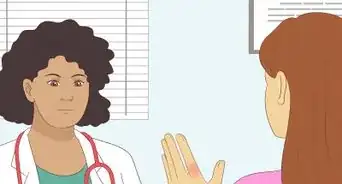

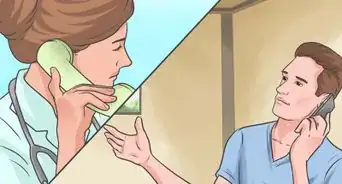
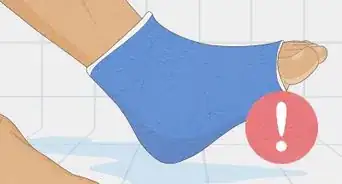

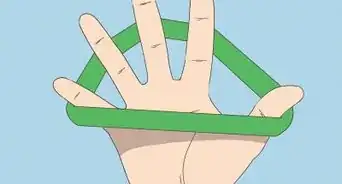

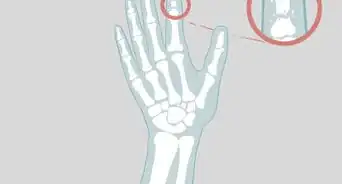

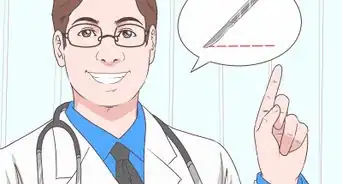












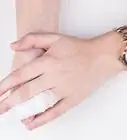






































Medical Disclaimer
The content of this article is not intended to be a substitute for professional medical advice, examination, diagnosis, or treatment. You should always contact your doctor or other qualified healthcare professional before starting, changing, or stopping any kind of health treatment.
Read More...